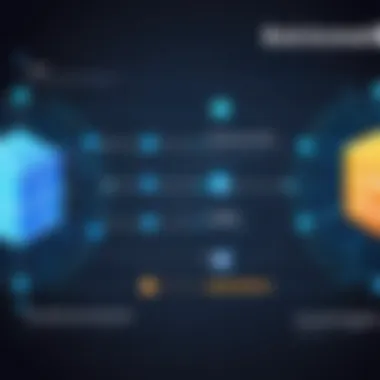Exploring Blockchain Technology: Principles and Impact


Intro
Overview of Topic
Blockchain technology has gained considerable attention in recent years. It is known primarily for its role underpinning cryptocurrencies, but its capabilities extend far beyond that. This section explores the essential concepts of blockchain, outlining its scope and significance in modern technology.
Understanding blockchain technology involves grasping its foundational role in increasingly decentralized systems. The decentralization aspect enhances transparency and reduces the control that any single entity can wield over data. Importance of blockchain in industries ranging from finance to supply chain management cannot be underestimated. Its birth can be traced back to the release of Bitcoin in 2009; however, the idea began a little earlier.
Brief History and Evolution
While blockchain as a term was popularized by Bitcoin, the groundwork was laid in the early 1990s. The concept of a timestamped chain of data was bubbling as an academic idea, but it lacked the catalyst that Bitcoin laid out. This paved the way for exploration beyond cryptocurrencies into various fields that today leverage this technology. The past decade has witnessed digital transformation and application at scales once unimaginable. Blockchain's potential, in theory, becomes highly critical.
Fundamentals Explained
At its core, blockchain is inherently about data management in a distributed ledger.
Core Principles
Several central ideas define how it operates:
- Decentralization: Financial power does not belong to one centralized organization but instead is spread out among network participants.
- Immutability: Once a transaction is recorded, it cannot be changed. This provides a reliable background for trust.
- Transparency: Everyone within the network can view transaction data if they have permission, enabling added accountability.
Key Terminology
A few key terms are essential for proper understanding:
- Node: Any active participant in the blockchain, which can be a computer, server or device that assists in maintaining the blockchain network.
- Block: A container capable of storing transaction data.
- Consensus Algorithm: Mechanism that allows agreement among network participants about the state of the blockchain legitimizing additions to the chain.
Basic Concepts
Starting from blocks and one kind of structure as chains shows the simplistic operational principles。
- Use a peer-to-peer network.
- Every transaction logged is timestamped.
Practical Applications and Examples
The advantages of blockchain technology manifest more clearly in various practical fields. Take a short look through the lens of real-world examples:
- Finance: Ripple is one example as it facilitates instantaneous cross-border payments, making existing solutions seem slow.
- Supply Chain: IBM's Food Trust project works to enable tracking the origin of ingredients more efficiently.
- Healthcare: MediLedger constructs safe protocols specifically dealing with the distribution of medicine.
Understanding Blockchain Technology
Blockchain technology is a pioneering advancement in the digital world that holds great relevance today. As our reliance on digital platforms grows, understanding blockchain becomes crucial. This article will explain blockchain's fundamental principles and significance across various sectors. Those involved in finance, IT, and programming must grasp its core mechanisms and potential implications.
Definition of Blockchain
Blockchain can be defined as a decentralized ledger technology that records transactions across multiple computers. This means that no single entity has control over the entire network, providing increased security and data integrity. Each transaction is grouped together in a block, which is then linked to the prior block, forming a chain. Hence the name blockchain.
The data is stored in a cryptographic format, making alteration nearly impossible without revising all subsequent blocks. This leads to trust between parties without needing intermediaries. The first widely acknowledged application of blockchain technology began with Bitcoin in 2009, which introduced the concept of a digital currency to the world.
Key Characteristics of Blockchain
Blockchain technology possesses key characteristics that distinguish it from traditional databases:
- Decentralization: Unlike centralized databases, blockchain distributes data across multiple nodes, which makes it less vulnerable to attacks.
- Transparency: All transactions are visible to users on the network. This transparency builds trust among users and decreases fraud risks.
- Immutability: Once recorded, changing data on a blockchain is nearly impossible, ensuring data integrity.
- Security: Advanced cryptographic techniques safeguard blockchain networks against unauthorized access.
- Consensus Mechanisms: The technology employs various consensus methods to validate transactions, enabling secure agreement among participants.
By valuing decentralization, transparency, and security, blockchain technology embodies a new way empowering users and revolutionizing industries.
In gathered understanding, these characteristics make blockchain particularly suitable for applications where trust and verification are of the utmost importance.
The Core Components of Blockchain
The core components of blockchain technology play a critical role in its functionality and applicability. Understanding these elements can enhance comprehension of how blockchain operates within various industries. Each component impacts how transactions are processed, secured, and verified, contributing to the overall efficiency and reliability of blockchain.
Blocks and Chains
Blocks form the core unit of data in a blockchain. Each block contains a list of transactions, along with a timestamp and a unique hash. This structure ensures that all upcoming blocks in the chain can reference and verify past transactions, which helps to maintain the chronological order of events. The chain aspect networks these blocks together. By linking them through cryptographic hashes, altering one block would require corresponding changes to all subsequent blocks. This feature is fundamental to ensuring data integrity, making unauthorized changes nearly impossible.


Decentralization
Decentralization is one of the most fundamental aspects of blockchain technology. In traditional systems, control typically rests with a single entity or administrator. However, blockchain distributes control across nodes in a network. This offers many advantages, such as reducing the risk of single point failures, enhancing security, and promoting trust. Each participant in the blockchain network retains a copy of the entire chain, which creates a more resilient system. This reinforces the blockchain principle of transparency while protecting against fraudulent activities and single-party manipulations.
Consensus Mechanisms
Consensus mechanisms are vital for validating transactions on a blockchain. They determine how all network participants agree on the validity of a transaction. Different types of mechanisms will shape how rapidly agreements can occur and how much energy is consumed.
Proof of Work
Proof of Work is a consensus mechanism that requires participants, known as miners, to solve complex mathematical puzzles to validate transactions. This process, commonly associated with Bitcoin, helps ensure network security by requiring substantial computing power. As a result, it has a deterrent effect against potential attacks. However, it is energy-intensive. While effective, some critics raise concerns about its environmental impact and sustainability. Thus, for blockchain to expand, addressing these concerns is necessary while exploring alternatives.
Proof of Stake
Proof of Stake offers another way to reach consensus without the high computational costs of Proof of Work. In this system, validators create new blocks based on the number of coins they hold and are willing to ``stake” as collateral. This reduces energy consumption significantly. Moreover, it can lead to quicker transaction times. Some studies suggest that Proof of Stake can provide a more equitable distribution of influence in block creation, although it poses its own set of challenges, such as the risk of centralization.
Delegated Proof of Stake
Delegated Proof of Stake is a variation of Proof of Stake where coin holders elect delegates to validate transactions on their behalf. This method can enhance speed and reduce decision-making times because fewer entities are making decisions. As a tailored approach, it suits scenarios where speed and efficiency are prioritized. However, it can create hierarchical structures that might lead to corruption or manipulation if the elected delegates are not held accountable.
"As blockchain technology continues evolving, understanding core components is crucial to Infrastructure that drives data security and decentralized governance."
Through studying the core components like blocks, chains, and various consensus mechanisms, one can appreciate how they stack together to form a stable and secure system. This is significant in exploring further sections of the article, as understanding these fundamentals will trigger insights into businesses using blockchain technology today.
The Evolution of Blockchain
Understanding the development of blockchain is crucial to grasp its current significance and future implications. Over the years, blockchain has transformed from a singular digital currency mechanism to a robust framework capable of supporting a wide array of applications. With each advancement, blockchain has showcased flexibility and potential, making its evolution a topic worthy of exploration.
From Bitcoin to Smart Contracts
Bitcoin emerged in 2009 as the first cryptocurrency, indeed heralding a new financial system. It is built on the principles of decentralization and transparency. Bitcoin used blockchain for transaction verification, which gave rise to trustless interactions. However, it was Ethereum, introduced in 2015, that truly expanded blockchain's capabilities beyond currency.
Smart contracts are self-executing contracts with the terms of the agreement directly formed into code. This innovation allowed transactions and agreements to be automated, reducing the need for intermediaries. Such programs allowed businesses to execute agreements efficiently, minimize disputes, and save time.
Some important benefits of smart contracts include:
- Efficiency: Transactions can occur rapidly without human intervention.
- Cost-effective: Reduced need for third-party services diminishes costs.
- Accuracy: Minimized human error enhances the reliability of outcomes.
The growth from Bitcoin's basic use case to incorporating smart contracts underscores how blockchain technology expands horizons for many fields beyond traditional finance.
Emergence of Decentralized Applications (DApps)
With the foundation lain by Bitcoin and Ethereum, decentralized applications, or DApps, have begun to take center stage. DApps are application programs that run on a blockchain network rather than being governed by a solitary entity. This aspect gives rise to resilience against censorship and increases the security for developers and users alike.
DApps also promote community involvement since many of them are designed to be open-source. This means anyone can contribute and potentially benefit from improvements.
Key considerations for DApps include:
- Decentralization: No single point of failure enhances both security and uptime.
- Incentive Structures: Tokens can incentivize multiple user interactions, fostering a self-sustaining environment.
- Interoperability: Different DApps can often interact directly with one another across blockchain platforms, increasing versatility.
In summary, the evolution of blockchain is marked by innovation and adaptability. From enabling Bitcoin to ushering in a new era with smart contracts and DApps, this technology has consistently pushed boundaries, leading to endless possibilities in a digital future.
Advantages of Blockchain Technology
Blockchain technology offers significant benefits that enhance various sectors and processes. Understanding these advantages is crucial for stakeholders, including businesses, developers and regulators, to leverage its full potential. This section explores three major advantages: enhanced security, transparency and trust, and reduced costs and efficiency. Each of these characteristics highlights the unique capabilities of blockchain, further enhancing its attractiveness in the digital landscape.
Enhanced Security
One of the standout features of blockchain technology is its robust security. Unlike centralized systems, where data is stored in a single location, blockchain distributes copies across a network of computers. Each block binds securely to the preceding block through cryptography, making it exceedingly difficult for unauthorized parties to alter data within the chain. Any change to a single block requires altering all subsequent blocks, which demands conspicuous amounts of computational power.
Additionally, blockchain utilizes decentralized networks, which further diminishes vulnerabilities associated with hacking. Because there is no single point of failure, it makes malicious attacks less likely. This intrinsic security is valuable in fields including but not limited to finance, healthcare, and government, where data integrity is paramount. The reliable use of encryption in transaction validity provides assurance, thereby reducing fraud and identity theft.
Transparency and Trust
Blockchain fosters transparency in all transactions. Each participant in the network has access to the same information as others, creating a well-documented, immutable record. This also creates opportunities for visibility where needed, reducing instances of deceitful practices and establishing trust.
- For example:
- In supply chain management, tracking goods can help ensure that products are sourced ethically.
- In asset trading, both buyers and sellers participate with clear relevant data variables, decreasing disputes.


As a result, individuals and organizations can operate with greater confidence, knowing once a transaction is confirmed, it cannot be reversed or altered. The implications of this are significant, particularly for sectors requiring high standards of accountability, such as finance and healthcare.
Reduced Costs and Efficiency
Incorporating blockchain into business processes can strip away excessive layers often present in traditional transactions.
- Transfer fees commonly associated with intermediaries, such as banks or payment providers, are diminished.
- Conciseness in Interaction reduces the time required for processing transactions, as there is less need for multiple parties to verify operations manually.
This reduced need for oversight results in faster settlement times and enhances operational efficiency. Businesses can save both time and resources, which can be redirected towards innovation and growth initiatives, creating a more streamlined working environment. Ultimately, lowering overall costs without compromising quality serves to benefit both businesses and consumers carrying higher value overall in services and facilities provided.
In summary, the advantages of blockchain technology hold significant relevance in today’s digital world. By embracing enhanced security, increased transparency and greater efficiency, stakeholders can position themselves well for the future.
Challenges and Limitations of Blockchain
Understanding the challenges and limitations of blockchain technology is pivotal. While blockchain has gained significant attention for its potential improvements in security and transparency, it is not without hurdles. Addressing these challenges is crucial for practitioners and developers who seek to innovate in this rapidly evolving field. By acknowledging what stands in the way of fully realizing blockchain's potential, users can make better-informed decisions and strategies.
Scalability Issues
Scalability presents a formidable challenge for blockchain systems. Many existing blockchains can process a limited number of transactions per second. For instance, Bitcoin can handle roughly seven transactions a second, compared to thousands in traditional payment systems such as Visa. This limitation highlights the issues when attempting to adopt blockchain on a larger scale.
Various techniques aim to improve scalability. These include Wednesday November 23 2023[
- Layer 2 Solutions: These work off-chain, handling transactions or data separately from the main blockchain. Examples include the Lightning Network for Bitcoin and Plasma for Ethereum.
- Sharding: This method involves splitting the database into smaller segments or shards. Each shard manages its data and transactions, potentially boosting the overall system capacity.
Tackling scalability problems necessitates ongoing collaboration between developers and users for effective implementation of enhancements in existing blockchain architecture.
Regulatory Concerns
The regulatory landscape for blockchain remains uncertain across various regions. Governments face the challenge of adapting laws and regulatory frameworks to account for blockchain and cryptocurrencies while balancing innovation with consumer protection. This uncertainty often sows confusion among businesses looking to adopt blockchain and interrupts implementation strategies.
Key regulatory concerns include:
- Legal Recognition of Transactions: Ensuring how jurisdiction views transactions completed on a blockchain can be conflicting, especially across borders.
- Anti-Money Laundering (AML) and Know Your Customer (KYC): Regulators demand consumers be protected, placing constraints on data collection and responsible use of modeled systems.
- Tax Treatment: Cryptocurrencies can blur lines in taxation policy, impacting required disclosures and compliance.
Without establishing transparent and coherent regulatory frameworks worldwide, the adoption of blockchain within industries may remain stagnant.
Environmental Impact
Environmental concerns associated with blockchain cannot be ignored. The significant energy consumption of some networks, particularly those utilizing Proof of Work, presents ethical and practical issues. For example, Bitcoin's energy usage is often criticized for its ecological footprint.
Determining a move towards some more sustainable practices is vital to mitigating environmental disadvantages. A few approaches include:
- Alternative Consensus Mechanisms: Shifting to Proof of Stake can reduce energy usage significantly. It can be a step in linking sustainability with performance. Proof of Stake achieves network consistency through holding versions of the cryptocurrency instead of intensive computing power.
- Integration of Renewable Energy: Communities are promoting projects aimed at coupling mining operations with renewable energy projects, thus reducing dependency on conventional energy.
Addressing environmental impact isn't just about rejecting blockchain technology; it's more about innovation in its principles and productivity.
Users must confront such challenges directly to harness blockchain technology efficiently. Understanding its limitations helps pave the way for innovations that improve not only the technology itself but also its acceptance into mainstream society.
Real-World Applications of Blockchain
Understanding how blockchain can be deployed in real-world scenarios is essential for grasping its transformative potential. Blockchain technology offers various applications that enhance functionality across multiple sectors. Its decentralized nature, combined with features like security and transparency, makes it instrumental in varied fields, particularly finance, supply chain management, and healthcare. Each application harnesses the core characteristics of blockchain, illustrating how it may reshape traditional processes.
Blockchain in Finance
Cryptocurrencies
Cryptocurrencies, like Bitcoin and Ethereum, suggest a mode of transferring value that is unmediated by traditional banking systems. Their decentralized framework allows users to transact directly, removing the need for banks. This promotes financial inclusion and faster transactions.
Key strength: Cryptocurrencies leverage cryptographic principles, ensuring secure and anonymous transactions. As digital assets, they are benefiting from lower transaction fees compared to traditional financial systems.
Unique features include being programmable. Thus, implementations like Bitcoin scripts enable complex transactions automatically. However, volatile markets pose a challenge, accumulating whishes for better stability features also.
Smart Contracts in Banking
Smart contracts represent self-executing agreements coded to enforce and automatically manage contractual terms. In banking, smart contracts facilitate trust and streamline transactions, reducing delays.
Characteristic: They eliminate manual intervention, which minimizes human error and enhances efficiency in transactional frameworks. Smart contracts execute decisions entirely based on pre-defined rules.
The bright side is the enhanced speed and reduced costs associated with operational inefficiencies. A drawback is the dependency on code accuracy; bad codings can result in unintended outcomes and locked funds, leading to valuable disputes.


Supply Chain Management
Traceability
Traceability is a critical advantage of blockchain in supply chain management. It provides a transparent method to track products from origin to the consumer. This fosters trust among stakeholders and informed decisions.
Key trait: Each transaction in the supply chain is permanently recorded on the blockchain ensuring an immutable and searchable history. Therefore, businesses can quickly access data related to sourcing, manufacturing, and shipping.
A distinct feature is real-time data availability. Companies can manage logistics timeliness effectively; however, inconsistencies across tech systems in entities might hinder effective implementation.
Fraud Prevention
Blockchain’s ability to enhance fraud prevention mechanisms is another compelling attribute. By verifying and authenticating data, it safeguards against counterfeit products or fraudulent claims.
Overall hallmark: Each transaction’s permanence in blockchain proves a significant inducement for accuracy and integrity. The use of encryption further enhances data fortification.
A unique implementation feature includes assurance of the authenticity of products shipped. On the flip side, initial investment and gradual adjustments can mount costs especially for small enterprises.
Healthcare Innovations
Data Security
Data security presents a conducive application of blockchain technology in healthcare. By elevating data privacy for patient records, blockchain can establish a more secure data sharing network.
Key property: Encrypted data prevents unauthorized access, protecting sensitive information. This gives medical professionals unlimited access to important data whenever they are entitled.
Notably, it enables patients themselves control their health records, thus increasing engagement. Yet, developing consensus on standards to secure overall interoperability remains vital.
Patient Privacy
Enhancing patient privacy capabilities is noteworthy in blockchain applications. Blockchain fosters changing paradigms of patient-centered care through anonymized health data usage.
Key aspect: It allows users to share select data without compromising personal identity. Patients can also withdraw consent at any time.
Challenges arise in terms of trustworthiness surrounding personal data tied through public networks, inciting concerns predicated on outside scrutiny by third-sector entities.
Blockchain technology offers solutions tailored to resonate across industries. Its capacity to not only innovate current processes but also address fundamental issues is a source of optimism for future developments.
The Future of Blockchain Technology
The future of blockchain technology holds immense promise and potential impact across numerous sectors. As the evolution of this fundamental technology continues, its integration into everyday life is likely to deepen. This section will explore emerging trends and potential new use cases, both of which signify significant adaptations in the technologies we currently use.
Emerging Trends
Several notable trends are developing in the blockchain space. It is important to be aware of these developments to understand how they might influence technology and society. Some emerging trends include:
- Decentralized Finance (DeFi): This movement is redefining financial services through platforms built on blockchain. These eliminate traditional intermediaries, allowing for more transparent and efficient transactions.
- Tokenization of Assets: More physical and digital assets are being represented as tokens on the blockchain. This allows for fractional ownership and easier transfers, thereby fostering liquidity in markets.
- Increased Interoperability: Collaborations among various blockchain platforms are becoming smoother. This increases capability and efficiency as systems work together seamlessly.
- Regulatory Adaptation: Cryptocurrency regulations are becoming more concrete as government bodies recognize the importance of oversight. This emerging regulatory framework can help foster confidence in the technology.
Blockchain technology is continually expanding its influence as it matures, steering conversation and innovation across industries.
Overall, these trends encourage innovation and broaden understanding of blockchain mechanics. They display the ability of blockchain to adapt to current needs, needing future assessments.
Potential New Use Cases
The practical applications of blockchain extend far beyond its current implementations. As adoption grows, new use cases are continuously emerging. Key potential applications include:
- Voting Systems: Secure and transparent voting could change how elections are conducted. Blockchain can minimize fraud and improve trust through tamper-proof records.
- Intellectual Property Management: IP is becoming increasingly complex to safeguard. Blockchain can help maintain rights by providing secure, verifiable ownership data.
- Identity Verification: Blockchain can provide decentralization for identity management. Individuals would have control over their own identities, enhancing online privacy and security.
- Carbon Credits Tracking: Monitoring emissions with blockchain could improve sustainability initiatives. This may create more accountable markets for trading carbon credits.
Finale
The conclusion of this article underscores the vital role blockchain technology plays in modern society. It encapsulates the various aspects covered throughout the article, including its architectural components, real-world applications, and the distinct advantages it offers over traditional systems.
The significance of understanding blockchain lies in its potential to reform how data is managed and stored. As industries seek greater efficiency and security, blockchain stands out as a promising solution. Here are some specific elements to consider:
- Integration Potential: Blockchain's versatility allows it to integrate with other emerging technologies such as Artificial Intelligence, IoT, and Big Data, resulting in transformative applications.
- Decentralization Benefits: Its decentralized nature increases trust and transparency, which are essential for sectors like finance and supply chain.
- Economic Impacts: It can reduce costs by streamlining processes and eliminating intermediaries, fundamentally altering traditional business models.
By summarizing the key points, the conclusion fortifies the relevance of blockchain technology as a foundational pillar for future developments across various sectors.
Key Takeaways
- Foundational Knowledge: It's essential to grasp the basic definition and core components of blockchain, as they form the groundwork for more advanced concepts.
- Diverse Applications: From finance to healthcare, the practical applications demonstrate the technology's broad utility.
- Recognition of Challenges: Understanding the limitations and challenges faced by blockchain can foster realistic expectations for its adoption.
- Future Considerations: Keeping abreast of emerging trends is crucial as they may dictate the trajectory of blockchain's evolution.
Final Thoughts on Blockchain's Impact
Blockchain is not just a technical innovation; it heralds a shift in operational philosophies across various fields. The ongoing advancements have the power to redefine our approaches to data security and trust in transactions. Each sector stands uniquely positioned to benefit from the incorporation of this technology. Yet, as we ponder the implications, it is necessary to be mindful of discussions around regulation and ecological impact.







